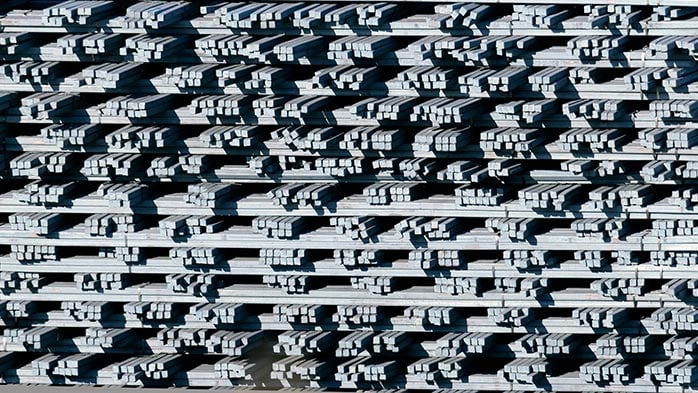Many market participants hold the view that rebar prices are mainly determined by demand – i.e. construction activity – and thus are very seasonal. However, German rebar prices tumbled in Q2 2017 despite booming construction activity in the country. A closer analysis shows that supply-side factors, principally import competition, and input costs such as scrap prices often outweigh the effect of demand.
Price falls amidst booming demand
The German construction sector is experiencing an extraordinary year. The order books of service centres and mills are completely full and some market participants are even reporting delivery problems. The production index of the German construction industry measured by the Federal Statistical Office of Germany hit its highest level in two decades. The unadjusted index reached 152.8 in May (the highest level since September 1997) whereas the seasonally and calendar-adjusted index reached 140.2 in March (the highest level since September 1996). According to wide-spread belief, rebar prices should have increased significantly from the calm winter months towards summer when construction demand is booming. Indeed, in the period 2010-2016, the average rebar price in the second quarter was €21 /t higher than the average price in the first quarter (see figure 1). This fact seems to strongly support the notion that rebar prices are driven by seasonal demand. However, 2017 appears to be fundamentally different: prices fell from €500 /t in February to €450 /t in June. This insight aims to establish a better understanding of the main drivers of rebar prices. It will demonstrate that rebar price movements are not strongly influenced by seasonal demand. Instead, they are mainly driven by changes in global scrap prices and import competition.
This fact seems to strongly support the notion that rebar prices are driven by seasonal demand. However, 2017 appears to be fundamentally different: prices fell from €500 /t in February to €450 /t in June. This insight aims to establish a better understanding of the main drivers of rebar prices. It will demonstrate that rebar price movements are not strongly influenced by seasonal demand. Instead, they are mainly driven by changes in global scrap prices and import competition.
This fact seems to strongly support the notion that rebar prices are driven by seasonal demand. However, 2017 appears to be fundamentally different: prices fell from €500 /t in February to €450 /t in June. This insight aims to establish a better understanding of the main drivers of rebar prices. It will demonstrate that rebar price movements are not strongly influenced by seasonal demand. Instead, they are mainly driven by changes in global scrap prices and import competition.
The myth of seasonality
At first glance, CRU’s historical data on rebar prices in Germany appears to support the hypothesis that rebar prices have a strong seasonal element. In the period 1991-2016, the average monthly price for rebar was highest in May and lowest in January, coinciding with the cycles of construction activity. However, at a closer look it becomes evident that this average is driven by a few outliers (for example, in 2008, right before the global financial crisis erupted, the rebar price in Germany increased from January to May by €330 /t). Overall, in the 26 years of this sample, the May price was higher than the January price in 15 years but lower in 11 years. This result is too mixed to convincingly support the belief that rebar prices are strongly seasonal.
Figure 2 displays the movement of the production index of the German construction industry, which is obviously seasonal, in comparison to the German rebar price, where no clear seasonality is noticeable. However, two other factors have a significant influence on rebar prices: Scrap prices and import competition.
Scrap prices provide a baseline
The price of scrap – the main input factor for the rebar production in Germany, which is exclusively EAF-based – obviously affects rebar prices.
Figure 3 shows that the differential between scrap and rebar varied around €200 /t with an average differential of €212 /t since 2010. The correlation coefficient between rebar and scrap prices is very high: 0.86. One might now wonder whether German scrap prices are determined by seasonal demand in Germany. However, German scrap prices move very much in tandem with global prices for scrap as figure 4 demonstrates.
Indeed, the correlation coefficient between German scrap prices and US scrap prices is even higher at 0.94. Thus, the scrap price is predominantly driven by global demand. The global scrap price thus provides a mostly exogenous baseline for the German rebar price, which rarely deviates much from the €200 /t differential.
Import competition caps potential price increases
The other major factor that determined German rebar prices in the first half of 2017 is import competition. Given the location of Germany in the midst of the European Single Market and the scarcity of anti-dumping duties on rebar (the only countries affected are Belarus and China), import competition is fierce. 2017 has seen even more rebar imports than usual, mainly because the Algerian authorities have essentially shut their market to European imports, which in turn pushed much Italian material north into Germany (see figure 5).
Import levels have increased by 44% y/y in the first quarter and German imports from Italy even climbed by 181% y/y. Overall, import levels reached 27% of apparent consumption in the country. The large price discount available for imported material has limited the possibility for German mills to lift the price for rebar meaningfully so far this year.
Conclusion
German rebar prices are heavily influenced by global scrap prices and import competition. The seasonal demand of the German construction industry plays a less important role in setting the price than most would expect.
Figure 6 shows that quarterly price movements follow no obvious pattern and that Q2 prices can be higher than Q1 prices in one year and lower in the next. Market participants who bank on increasing prices towards the summer have been misguided in 12 out of 27 years. Betting on seasonal price movements thus nearly equals roulette gambling. There is more evidence for falling prices in the second half of the year, but even then the price moves contrary to demand in around a third of the years in the sample. In short, supply-side factors or input costs often outweigh the effects of construction demand and thus enable the rebar price to move counter-seasonally.
We expect import levels to recede in the coming months. Algeria is finally about to issue import licences. Therefore, Italy will start exporting rebar to Algeria, which should ease the pressure on German mills. Due to rising prices in East Asia and strengthening domestic demand in their markets, imports from Russia and Turkey will remain low. Furthermore, scrap prices are expected to gain more strength in coming weeks due to rising global steel prices and increasing steel production in Turkey. Thus, CRU forecasts rebar prices in Germany to hold steady or even increase slightly although construction activity traditionally wanes during the holiday season in August.
Moving towards Q4, there are two main risks surrounding our price forecast. Firstly, the ongoing Section 232 investigation into steel imports in the USA represents a significant upward risk on scrap prices. Should restrictions be imposed on steel imports, this would likely increase steel prices in the USA and in turn also lift scrap prices. As demonstrated, German scrap prices usually follow scrap prices in the USA, thus driving rebar prices up.
Secondly, there is a major downward risk on prices represented by increasing overcapacity in Europe. The Algerian government aspires to reduce the country’s dependence on steel imports and eventually become self-sufficient. The inauguration of Tosyali Algeria’s new 2 Mt/y rebar capacity in Bethioua and the commissioning of Algerian Qatari Steel’s 1.5 Mt/y rebar capacity in Bellara contribute to the achievement of this goal. Therefore, CRU expects that Italian mills will soon lose any opportunities to export rebar to Northern Africa. This will permanently increase overcapacity in Europe and heighten import competition in Germany.

















